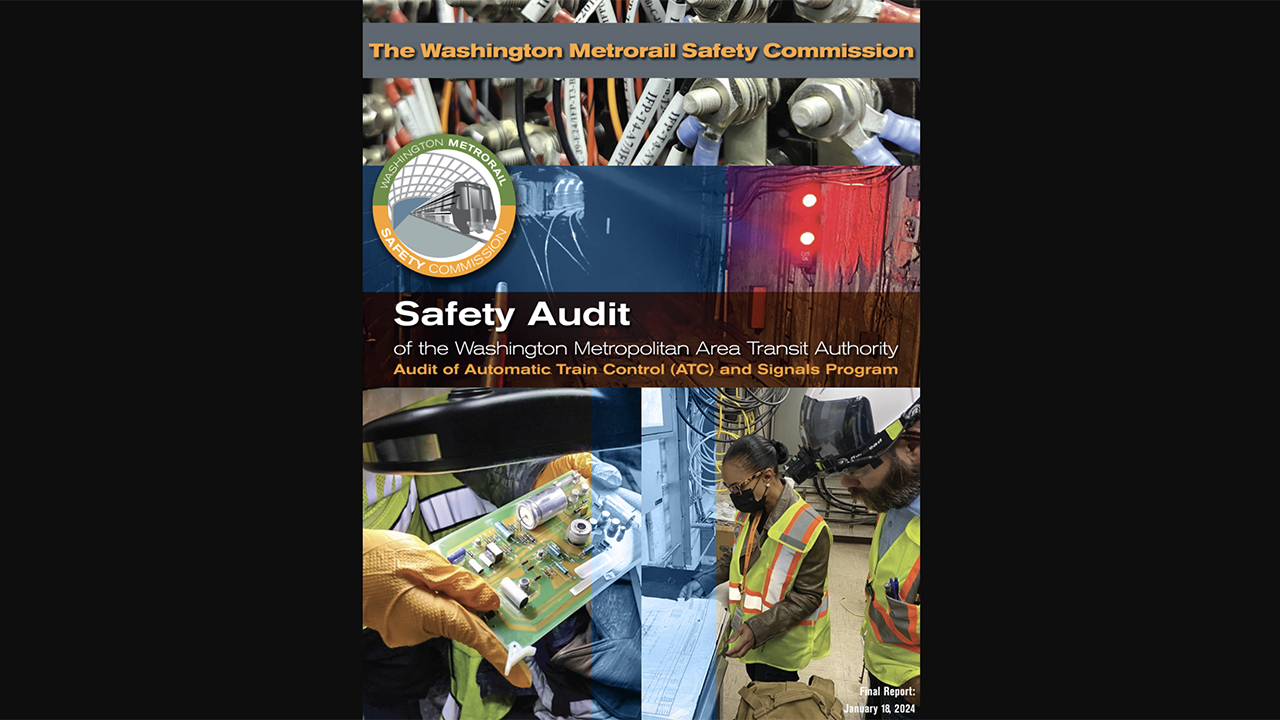
WMSC Issues Safety Audit of WMATA’s Automatic Train Control, Signals Program
Written by Marybeth Luczak, Executive Editor
Washington Metropolitan Area Transit Authority (WMATA) Metrorail has implemented improvements to its automatic train control and signals program, but “is not carrying out some key safety commitments,” according to the Washington Metrorail Safety Commission’s (WMSC) most recent safety audit, released Jan. 18. In addition to providing five findings and three recommendations for WMATA to address, WMSC outlined positive practices at the rapid transit system serving 98 stations in Virginia, Maryland, and the District of Columbia.
The audit (download below) took place in 2023. WMSC conducted in-depth interviews, site visits, and document and data reviews in March and April 2023, with additional follow up and document review in May and June 2023. The aim, it said, was to assess WMATA Metrorail inspection, maintenance, and engineering practices and procedures, and associated training for purposes of compliance with applicable plans, policies, regulations, and industry best practices.
The automatic train control system “provides critical safety protections” for train movement and roadway workers, including safe train separation, prevention of overspeed derailments, fail safe train detection, broken rail detection, interlocking rules enforcement, hazard response and work zone protection, WMSC explained. WMATA Metrorail’s automatic train control system design relies on fixed blocks based on track circuits. “When a train (or a shunt placed by roadway workers) is in a particular section of track, it changes the flow of the electric current that runs through the running rails, which de-energizes a relay, which causes the block to indicate as occupied,” WMSC said. “Information about occupied blocks, signal status and other factors flows through equipment in train control rooms including ATC [automatic train control] modules and Remote Terminal Units, then through communications lines to reach the Advanced Information Management (AIM) system used by the Rail Operations Control Center (ROCC) to monitor and direct train and personnel movement.”
WMSC’s audit reviewed all associated automatic train control and signaling facilities, equipment, systems, and software on both the mainline and in yards, such as but not limited to remote terminal units (RTU); train control rooms (TCR) and constituent parts; communication lines, devices, and any associated cabling; and the Advanced Information Management (AIM) system, but excluding how the Rail Operations Control Center uses the information typically provided by AIM.

The audit provided five findings and three recommendations for WMATA to address. The findings are:
- “Metrorail ATC [automatic train control] Maintenance personnel do not have a uniform understanding of Metrorail procedures, which leads to inadequate completion of safety tasks, such as inspections and handling of vital systems, that are required to ensure that track circuits and other elements of the ATC system function properly as required to prevent train collisions and to provide other designed safety protections.”
- “Metrorail does not review, analyze, and act upon available safety data about the health and functionality of the Automatic Train Control system and subsystems as required by Metrorail’s Agency Safety Plan. Therefore, Metrorail’s ATC [automatic train control] Engineering cannot reliably or proactively determine whether or not the ATC system and subsystems are or will be functioning as designed to provide for the safety of riders and workers.”
- “Metrorail is putting its personnel at risk due to health hazards such as damaged and repositioned materials marked as containing asbestos that are not being identified and managed as required by its Agency Safety Plan.”
- “Metrorail is not systematically identifying, tracking, and mitigating hazards related to automatic train control and signaling as required by its Agency Safety Plan.”
- “Metrorail is not maintaining its books of plans in accordance with its requirements.”

WMSC made the following three recommendations:
- “Metrorail has not determined the required staffing for ATC [automatic train control] and Signals.” WMSC reported that the Metrorail personnel interviewed “expressed concern about staffing and alignment within Metrorail’s Communications and Signaling Department, and the desire to conduct a staffing and organizational assessment to determine the required staffing levels for specific tasks.”
- “Metrorail does not ensure that lessons learned from prior projects are consistently shared with all relevant personnel responsible for ATC [automatic train control] and Signals.” According to WMSC, audit interviews “demonstrated that lessons learned, particularly as part of capital projects, are developed but are not consistently shared and incorporated across ATC [automatic train control] and Signals personnel. Proactively and consistently sharing lessons learned more broadly can help an organization like Metrorail avoid repeating similar issues and promote repeating of positive outcomes.”
- “Metrorail does not have a procedure for the removal of hang tags in Train Control Rooms that indicate temporary modifications. This has led to many rooms having such ‘temporary’ hang tags in place for decades.” WMSC said its audit team “observed temporary hang tags on wires in many Train Control Rooms that had been in place since the 1970s, 1980s and 1990s.” As described on the tags and in interviews, Metrorail “intends these blue or tan tags to indicate temporary modifications from the printed book of plans, such as the use of spare cables, that would then be replaced in the future or incorporated into permanent future updates to the books of plans used for troubleshooting and other work,” WMSC noted. “However, Metrorail has no process to incorporate the information and remove these tags to provide for clearer access to wiring and provide assurance that the books of plans are accurate.”
WMATA Metrorail is required to propose corrective action plans (CAP) to address each finding and to respond to each recommendation no later than 30 days after the issuance of the WMSC report. “Each proposed CAP must include specific and achievable planned actions to remediate the deficiency, the person responsible for implementation, and the estimated date of completion,” according to WMSC. “Each proposed CAP must be approved by the WMSC prior to WMATA implementation. For each recommendation, WMATA must either propose a CAP or submit a hazard analysis and associated documentation as required by the WMSC Program Standard.”

WMSC also outlined the “positive practices” it found at WMATA Metrorail:
- “Following the WMSC’s August 2022 Train Control Room order and finding, Metrorail has improved conditions in some Train Control Rooms.
- “Metrorail has developed and begun offering refresher training for AA, A, and B ATC [automatic train control] mechanics.
- “Metrorail has developed and is carrying out on-the-job training on specific switches and track circuits as committed to in CAP [corrective action plan] C-0112.
- “Metrorail has a training lab for ATC [automatic train control] personnel, is planning a second facility at the Dulles Rail Yard that is to include Silver Line Phase 2 equipment, and has a switch training location at Telegraph Road.
- “Metrorail departmental leadership is tracking bobbing track circuits, and Metrorail documents addressing locations with regular issues.
- “Metrorail is trialing monitoring devices on some switch machines.
- “Metrorail is governing PMI deferral requests through a documented process that ensures PMIs are documented as completed as scheduled except in instances such as long-term shutdowns where access is not available and train movement will not occur, and that requires engineering approval for any deferral.
- “At the time of this audit, Metrorail was testing an alternative microswitch in a Grand Master 4000 at the D&G Junction (where the Orange, Blue and Silver Lines diverge east of Stadium-Armory Station) to address some previous issues (see 2021 WMSC ATC Audit) and attempt to improve reliability. Metrorail had first tested the replacement microswitch at the Telegraph Road training facility, leading to additional adjustments before installation on mainline.”



